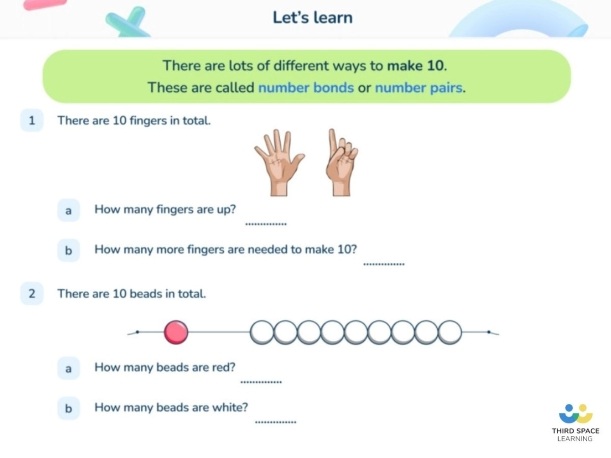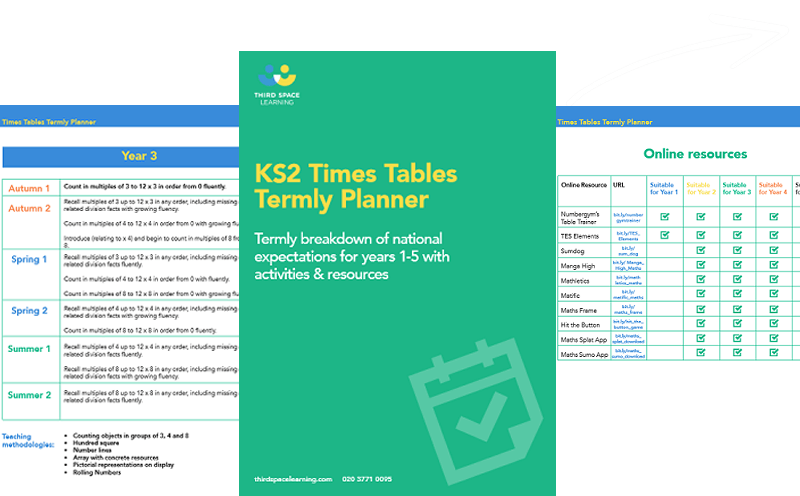Number Bonds To 10 Activities And Other Practical Ways To Learn Number Facts In KS1 & KS2
Number bonds to 10, number bonds to 20 and other number facts are part of the essential foundations for Maths at primary school, but being able to teach them in a way that promotes rapid recall is hard. Here are some number bond to 10 activities and other number facts activities that have worked for me.
Why do we need these number facts activities?
All pupils need a bank of key number facts they have learnt stored away, which they can draw on at any time.
These number facts must be held in their long term memory and they must also be able to recall them instantly. It is great if a KS1 pupil can confidently tell you what 8 lots of five are by counting on their fingers, but this takes time and the fact is not fully learnt until they can use their number facts to answer your question in a Maths lesson in a split second.
Focus on formal algorithms and arithmetic testing
With the changes to the curriculum, particularly a focus on formal algorithms and arithmetic testing, it is becoming more important than ever that the children we teach can quickly and confidently recall key facts in maths.
Such mental maths strategies include number bonds to 10, number bonds to 20, common patterns, doubles/halves as well as the usual times tables. These facts provide the foundation upon which they will then be able to practise and build their problem solving skills, their ability to answer simple word problems, and eventually more complex multi-step and 2-step word problems in KS2.

Repetition isn’t the only answer
So, what can we as teachers do to support our pupils? Whilst repetition, repetition, repetition will work for some, it will not work for all. And in the primary classroom, whether KS1 or KS2, it’s really important that we try out new and varied strategies which make this element of learning as exciting and engaging as possible.
My 5 favourite number bond to 10 activities
The following list is a mix of things I have found effective with classes I teach and ideas and interventions that I have seen colleagues put into action.
KS1 & 2 Times Tables Termly Planner
Breakdown of curriculum expectations for times tables, including teaching strategies and an online resource bank
Download Free Now!1. Classroom games
Making maths fun is really important and one of the easiest ways to do this is by integrating practise into your classroom using a range of KS1 maths games. Two that my classes have always loved are “Last man standing” and “Round the world” when I ask them number bond to 10 questions. But of course, there are loads of different ones to try. The important thing is to try and differentiate your questions based on the pupil that is answering so that they can all access it.
2. “SPLAT”
A great way to make use of the interactive whiteboard is to make a game of splat. Place answers to times tables questions around your screen. Then get two pupils to stand in front of the board. When you call out a number bond to 10 or number bond to 20 question the first pupil to “splat” the answer is the winner. You can play this individually or split the class into two teams and keep score.
3. Practise during transitions
A great time to practise number bonds to 10 or 20 or more is during “transitions”, when pupils are moving from their desks to the carpet, or getting ready to line up at the door. If you consider that each time you do this you are using up at least a minute or so of time, think how much practise time on number facts you could gain in a week.
I used to get my class to recite their number bonds or count up or back in various steps when moving to and from their desks. This does require you to have strict rules about when they start and stop counting but I have found it really effective. Not only does it give them more time to practise but it also stops them having the chance to chat or squabble as they move around the class – a win win in my books!
4. “Ask me!” badges
A nice way for pupil to share their achievements and keep practising is to give them a badge encouraging people to ask them a particular set of number facts they have learnt, e.g. “I’ve learnt my number bonds to 10 – ask me!” Then, when they walk around school other members of staff can see what they’ve been working on, praise them and check their understanding. It also serves as a handy reminder of their target to both the pupil and teacher. Obviously it’s best not to do this before they have had the chance to practise and become confident or it could be too daunting for them.
5. Pupils as Teachers
We all know the statistics about remembering 90% of what you teach others, so hand the control to the children and get them to help each other. You could try putting them in groups and tasking them with creating a rhyme or poster on a particular set of number facts – then pair the groups up and get them to do a mini lesson or presentation and teach each other.
My 5 favourite number facts activities – great for times tables
1. Target Board Starter
This one can be a nice starter for your maths lessons each day and is a good way of testing pupils’ recall of a wide range of number facts. Display a 4 x 5 grid on your whiteboard and fill it with a variety of numbers. They can be whole numbers, decimals, fractions, percentages. Then come up with a list of questions for the answers on the board.
Each day spend 2-3 minutes asking children to find the answers e.g. “Which numbers are multiples of 10?”, “Write down 3 factors of 25 which you can see” “Find the number which is double 18”. The nice thing about this is that the pupils know the answers are there on the board, so it’s not as daunting for those who might need a bit of support. It is also really easy to provide a wide range of more simple and challenging questions. You can also try getting the pupils to take it in turns to come up with the questions.
2. Rolling Numbers/Times table chants
I embraced this approach to times tables memorisation with my classes and the children loved it. It is essentially an update on the age old approach of chanting but adding in some more exciting elements: a rhythm, some rhymes, actions…whatever you like to make a catchy and easily remembered times table rap. The chant for the 7 time table involved stamping on the floor and my class always threw themselves into it with great enthusiasm (although I’m not sure how much the teacher in the room below us appreciated it!).
3. Times Table Rockstars
Again, a modern take on a very traditional approach: testing. But with this, rather than just completing a standard times table test once a week in silence, the idea is to complete as many of the fifty questions as quickly as possible whilst also listening to a rock song. Then, based on their finishing time, children become “Rockstars”, “Rock legends”, or “Rock Gods”. This was great for the competitive children in my class and I found that the music helped them focus (our favourite song was Eye of the Tiger) as well as making it a more fun approach generally. For the musicians amongst you this also provides a great way to educate your class in classic rock music as it’s up to you to choose the tracks! Find out more on the Times Tables Rockstars inspiring website.
4. Counting Stick Times Tables
I found this quite traditional teaching method to be one of the most effective for times tables. It seems very simple but I was consistently surprised by how much my children loved it and it really did help the facts stick in their memory. All you need is a metre stick which is clearly divided into 10cm sections and some post-its.
Write each multiple of a particular times table on a post-it and stick them along the metre stick. Start by getting the children to recite “1 times 4 is 4, 2 times 4 is 8 etc…” with you as you point to each section on the counting stick. I like to count up, backwards then mix it up by pointing to different sections out of order.
Once you have done that a few times, start to remove a few post-its and repeat the same steps of chanting again. Repeat the process of removing post-its and chanting until there are none left and the children are saying the number facts from memory. My class used to love the challenge as they saw the post-its being taken away and would even ask for me to remove more sooner!
5. Get parents involved
Getting children to spend time learning and memorising number facts at home can be hard and many children will try to avoid it if they can. Try to get parents on board as early as possible by suggesting activities they can do together at home. But keep it simple – for busy working parents finding the time to sit down to a complicated activity can be hard.
For early key stage one, things like playing board games can be useful to reinforce counting on and back. I also often suggest making a game of counting up and down in steps of 2, 5 and 10 when going up and down steps or just walking along the pavement.
Try this great number facts activity for parents and children to do at home or our selection of fun maths games for kids to do at home.
Which of these number facts activities have worked best for you?
These are only a few suggestions – there are so many different activities to try as we know from working one-to-one with primary pupils every week!
The important thing is that we give our pupils the chance to practise these number facts as much as possible. This will help build their confidence and develop their enthusiasm for tackling harder calculations, knowing that their knowledge of things like times tables won’t be a barrier.
Read more:
DO YOU HAVE STUDENTS WHO NEED MORE SUPPORT IN MATHS?
Every week Third Space Learning’s specialist online maths tutors support thousands of students across hundreds of schools with weekly online 1 to 1 maths lessons designed to plug gaps and boost progress.
Since 2013 these personalised one to 1 lessons have helped over 150,000 primary and secondary students become more confident, able mathematicians.
Learn how the programmes are aligned to maths mastery teaching or request a personalised quote for your school to speak to us about your school’s needs and how we can help.




